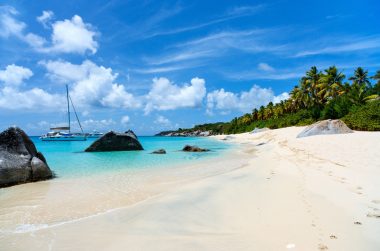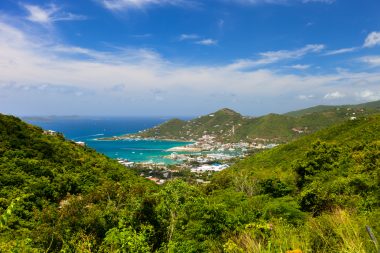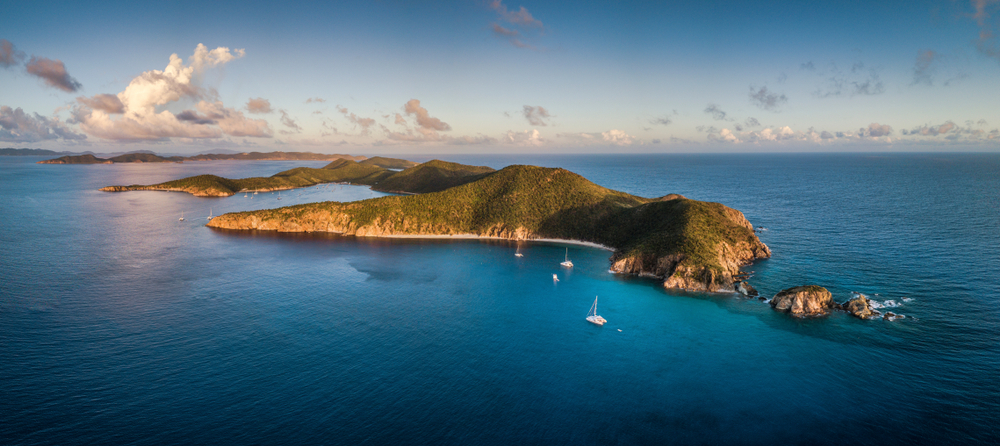If you search for the northern end of the Antilles arc on the globe, you will inevitably come across sixty paradisiacal islands. The British Virgin Islands – they are undoubtedly the epitome of all the clichés that vacationers make of an exotic dream destination. Green rainforests stretch up to the peaks of the mountains, and on the beaches the palm trees bend in a mostly mild wind. And if you haven’t chosen the hurricane season as the date for your trip west, you can hope for carefree days without significant precipitation and temperatures between 26 and 32 degrees Celsius.
Columbus and the memory of Saint Ursula

Twice, Her Majesty the Queen of England traveled to her distant enclave in the British Virgin Islands. Much earlier than the Queen, Christopher Columbus set foot on the snow-white beach of the archipelago. And in a romantic fit, in view of the beauty of the Antilles, he remembered the eleven thousand virgin companions of St. Ursula on her pilgrimage to Rome. And so the name of the British Virgin Islands manifested itself from that day until eternity.
Sugar cane plantations and orchids in the rainforest
On the Queen’s paradisiacal territory, the British Overseas Territory in the Caribbean, the Lesser Antilles resemble a rainbow. Of the sixty islands, not all are inhabited. The majority of the barely 32,000 inhabitants live in Tortola, the main island of the British Virgin Islands. This is then the starting point for sailing trips to the neighboring tiny islands and their unique beaches. Sugar cane plantations dominate the landscape almost everywhere, and over time they have increasingly displaced the once dense rainforest. If you are on the trails of Sage Mountain National Park, you will still be intoxicated by the splendor of orchids and bromeliads.
Brightly colored fish on the coral banks
Those who enjoy sun, sand and a warm sea in the British Virgin Islands will also be delighted by the numerous versions of the water sports offered there. Divers and snorkelers in particular get their money’s worth in the coral gardens on the doorstep of the Antilles group. This is the territory of the large and small inhabitants of the sea. There are shoals of brightly coloured fish but also lobsters, brittle stars and sea eels. It is probably difficult for every visitor to create a ranking of the most beautiful islands on the rainbow. If you want to experience the most important ones, you should remember these names: Beef Island, Cooper Island, Anegada, Jost van, Norman Island, Peter Island, Ginger Island, Salt Island and especially Virgin Gorda and Tortola. To get an overview of the British Virgins, visitors are recommended to climb the 534-meter-high Mount Saga. From here there is an impressive panorama over the tropical forest to the impressive bays.
Diving excursions to a sunken steamer

The beaches in the British Virgin Islands are not only miles long, but also virtually deserted. Here everyone will find their place in the sun or under the roof of a palm tree. Virgin Gorda is one of those islands that has opened up to international tourism to a particular extent. Snorkeling on one of the beaches is an enjoyable pastime here. Salt Island lives up to its name, because it was derived from a salty basin. There, divers will find a special destination off the coast – a steamship from the 19th century, which was killed by a coral bank. If you dare to go a little further out to sea, you can look forward to an encounter with dolphins and whales frolicking in the blue waves on the doorstep of this British overseas territory.
A special mixtura: nature and culture
It is not known whether a few hundred years ago the notorious pirates also had an eye for the exotic splendor of this landscape. The fact is that they found some of their secret loopholes on Virgin Island. The wrecks of sunken ships are silent witnesses of this time. Traces of legendary buccaneers of the seas can be found especially on Norman Island. Virgin Gorda is proud of a geological attraction of the first order, as the system of caves there is unique in the Antilles. The island of Anegada owes its formation to a volcano. In general, all the islands in this group are of volcanic origin. In a botanical garden on Tortola that is well worth seeing, nature and culture combined to create a particularly interesting mixture.
Freshly caught seafood to Caribbean sounds
Sunsets are of course free in the British Virgin Islands. A cool drink in one of the numerous pleasant resorts is a great way to end a day. But also with a candlelit dinner by the sea. Freshly caught seafood is served almost everywhere on the terraces of the restaurants, and the Caribbean sounds that can always be heard from the loudspeakers make a holiday in this region of the Caribbean complete. British Virgins are a year-round destination, but the most popular time for tourists from all over the world is between December and April. English is spoken on all islands, but sometimes it is mixed with a Creole dialect that is difficult to understand. Anxious creatures among the holidaymakers should also know that there are no dangerous animals and no snakes on the islands.
Facts about the British Virgin Islands
- Location: The British Virgin Islands are located east of Puerto Rico in the Caribbean. They consist of about 60 islands and islets, of which only 16 are inhabited.
- Main Islands: The four largest and most important islands of the British Virgin Islands are Tortola, Virgin Gorda, Anegada, and Jost Van. Tortola is the largest and most populous island.
- British Overseas Territory: The British Virgin Islands is a British Overseas Territory, which means that it is a dependent territorial authority of the United Kingdom. The government consists of a governor, appointed by the British government, and an elected prime minister.
- Tourism: Tourism plays an important role in the economy of the British Virgin Islands. The islands are known for their white sandy beaches, clear turquoise waters, and excellent sailing and diving opportunities.
- Tax haven: The British Virgin Islands have a reputation for being a tax haven. Many international companies register their business there in order to benefit from the favorable tax advantages.
- Natural beauty: The British Virgin Islands are known for their stunning natural beauty. In addition to the beautiful beaches, they also offer impressive landscapes, such as the famous Baths on Virgin Gorda, a collection of granite rocks and grottoes.
- Sailing paradise: The British Virgin Islands are a popular destination for sailors from all over the world. The archipelago offers ideal conditions for sailing, with constant trade winds, sheltered anchorages and numerous bays and islands to explore.
- Historical significance: The history of the British Virgin Islands is closely linked to the colonial era and the slave trade. The islands were settled by the British in the 17th century and served as an important base for the triangular trade between Europe, Africa and America.
- National Park: A large part of the islands is protected as a national park. BVI National Park includes various areas, including the aforementioned Baths on Virgin Gorda, as well as protected marine areas, historic sites, and hiking trails.
- Population and culture: The population of the British Virgin Islands is diverse and is made up of various ethnic groups, including Afro-Caribbeans, Creoles, Amer Indians, and people from other Caribbean countries. The culture reflects this diversity and is shaped by African, British and Caribbean influences.
Museums
- The Virgin Islands Folk Museum (Road Town, Tortola): The museum offers a glimpse into the traditional way of life and culture of the people of the British Virgin Islands. It displays a variety of artifacts, including tools, handicrafts, musical instruments, and traditional clothing.
- The Old Government House Museum (Road Town, Tortola): This museum is housed in a restored colonial building that was once the government house. It presents exhibitions on the history of the islands, including the period of plantation economy and slavery.
- The H. Lavity Stoutt Community College Virgin Islands Maritime Museum (Parham Town, Tortola): The museum is dedicated to the maritime history of the British Virgin Islands. It presents models of historic ships, nautical instruments, artifacts from underwater archaeology and information about the marine environment of the region.
- The North Shore Shell Museum (Anegada): This small museum displays an impressive collection of shells from the region. It also provides information about the marine fauna of the British Virgin Islands and the importance of marine conservation.
- The Arawak Museum (The Valley, Virgin Gorda): Housed in a traditional Arawak house, the museum offers a glimpse into the lives of the indigenous Arawak people who once lived on the islands. It displays archaeological finds, tools and works of art from the Arawak culture.


